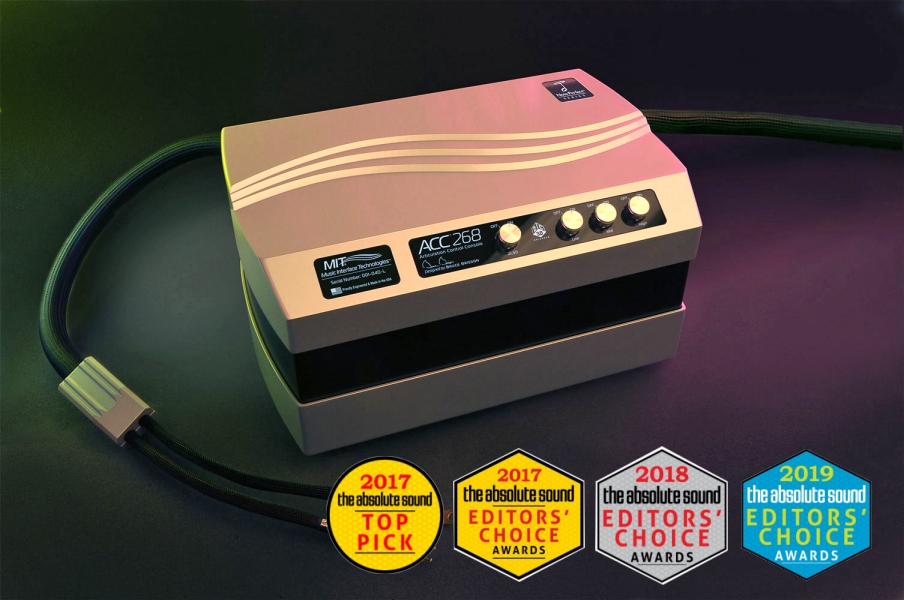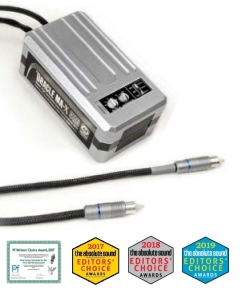
Music Interface Technologies ACC 268 Articulation Control Console and MA-X SHD Interconnects
Robert Harley | July/August 2017

What the heck is an Articulation Control Console?
To a cynic, it’s nothing more than a fancy name for a speaker cable. To others, the Articulation Control Console represents the culmination of everything MIT founder Bruce Brisson has learned over his 35-plus-year career designing interfaces between a power amplifier and a loudspeaker.o.
What everyone will agree upon, however, is the breathtaking price of MIT’s ACC 268 Articulation Control Console evaluated here—$80,000 per pair. I’m acutely aware that most of you will find that number obscene. Nonetheless, this groundbreaking product exists, and sales have been brisk. In fact, delivery of my review pair was repeatedly delayed because MIT couldn’t keep up with the demand. The review pair bore serial number 54, suggesting that MIT had 53 customers for the ACC 268 in the first few months since its introduction, without benefit of advertising or reviews. Because there’s a market for such a product, and the ACC 268 ventures into uncharted technical territory, it’s worth evaluating and reviewing. I would never be able to afford such a product, but there are readers who could. Moreover, the ACC 268 speaker interface and MA-X SHD interconnects are new versions of speaker interfaces and line-level interconnects that I’ve used as my reference for more than eight years. Remember, the name of this magazine is, after all, The Absolute Sound.

The ACC 268 is the top model in the three-product ACC line, which includes the ACC 169 and ACC 206. The numbers in the model names refer to the number of “poles of articulation” in the interface. For the very few who are sufficiently well-coined to afford the ACC 268, along with a system for which it is appropriate, there’s nothing quite like it. Take its sheer physicality for starters. The consoles are 48-pound sculpted aluminum enclosures that house the termination electronics along with four knobs, the function of which we’ll get to in a minute. The spade-lug-terminated cables—one input and one output—attach to the console via massive screw-on industrial-grade connectors. The cables that run from the console to your speakers, and from the console to your amplifier, are thick and heavy. Be prepared to give up some floor space to accommodate the ACC 268.The ACC 268 is essentially the technology platform of MIT’s Oracle MA-X speaker interface, but with more elaborate execution along with the addition of “Articulation Control” adjustment ability. The ACC 268’s adjustability takes the form of four knobs on the console’s top panel. Three of the knobs are marked “Low,” “Mid,” and “High,” respectively. The fourth on-off knob is marked “2C3D” (Two- Channel, Three-Dimensional). Rather than interpret the idea of “articulation” in cables, I’ve included an interview with Bruce Brisson so that you get the story straight from the horse’s mouth. I’ll address the sonic effects of these adjustments later in the review.
The console is machined from a solid block of aluminum, with the large internal volume dictated by the size and number of components inside, along with the space needed for optimal layout of those components. These components include the termination networks, the control boards that hold the switches, and a vibration-isolating plinth on which the components are mounted. The control boards them-selves reportedly contain 100 circuits. Each pair of consoles requires about 200 man-hours of hand labor to build. The cable part of the whole affair is constructed from large-diameter conductors that are hand-twisted in a specific pattern and twist ratio. There are actually three stages of this twisting, with a technician measuring and then adjusting the twist at each stage.
The MA-X SHD interconnects are a revised and upgraded version of the previous generation Oracle interconnects. They also offer adjustable “articulation” via two small knobs. One of these knobs engages low-frequency articulation, while the second, marked “mid,” offers a six-step adjustment—plus and minus three steps from the neutral setting. A slider switch optimizes the interface for the particular input impedance of the components the source component will be driving. If you don’t plan to change equipment, the MA-X SHD can be custom built for your particular components’ input impedances. The custom interconnects omit the adjustable impedance switch but retain the articulation adjustments.
MIT offers this impedance adjustability because component input impedances vary wildly from manufacturer to manufacturer. There is no industry standard except in professional audio where the input impedance of components is always 600 ohms. But the input impedance of consumer equipment can vary from a few hundred ohms to more than 1M ohm (one million ohms), with most falling in the range of 50k ohms to 200k ohms. The three switch positions on the MA-X SHD are marked “Low, 5–50k ohms,” “Mid, 40k–100k ohms,” and “High, >90k ohms.”
Before getting to these new cables it’s worth revisiting why I’ve used MIT’s top speaker interfaces and interconnects as my reference for many years. As I mentioned, the ACC 268 is essentially the Oracle MA-X SHD speaker interface with the addition of the articulation control technology. I’ve found that MIT cables in general, and the Oracle in particular, offer a particular combination of compelling virtues. First among these is their rich and dense rendering of tone color, particularly in the upper bass through the lower treble. I don’t want to use the term “warm” because that implies a coloration, but the MIT products are the antithesis of thin, bright, threadbare, skeletal, edgy, bleached, and analytical. To me, MIT cables reproduce instrumental timbre with a body, saturation of tone color, and weight that is more like the sound of live instruments. In addition, MIT cables have tremendous clarity, resolution, and open-ness but without a hint of brightness or etch. The tonal balance is a bit of a paradox, at once voluptuous and neutral, resolving and smooth. In addition, the Oracle products reveal a richly textured and layered soundstage, with tremendous dimensionality and air. Images appear along a depth continuum, separated by a tangible sense of air.
The ACC 268 and revised MA-X SHD start with the sonic performance that I’ve just described, but now bring something new to the party: the ability to tailor the sound to your particular system. Starting first with the impedance adjustment on the MA-X SHD interconnects, I found that setting the switch in the correct position produced the most natural timbre and tonal balance. With the impedance switch intentionally set in the wrong position (for my particular components) the sound was still superb. In fact, I heard nothing amiss. But when set to the correct impedance, the music had a more organic and natural quality, with greater fidelity of timbre. Instrumental tone color was more realistic, and the harmonic balance was more natural and less synthetic. The sound was overall more relaxed and involving. Going back to the incorrect setting (again, for my particular components), I heard a tincture of hi-fi artificiality rather than a natural ease.
"The sonic changes they render are unlike any other differences I’ve heard between components."
"No other cable I’ve heard offers the MIT’s foundational virtues or its flexibility in tuning a system’s sound."
The effects of engaging the articulation knobs on the ACC 268 are difficult to describe because the sonic changes they render are unlike any other differences I’ve heard between components, never mind speaker cables. Turning one of the articulation switches to the “On” position didn’t change the tonal balance, soundstaging, resolution, transparency, or any of the other typical characteristics we commonly associate with an alteration of the sound. Rather, the articulation control seemed to increase the textural density through the particular frequency band affected by the control (one control each for bass, midrange, and treble). That is, increasing the articulation rendered tone color with a greater timbral richness and solidity. Concomitantly, the sound had a greater dynamic verve and alacrity that made whatever speaker I was listening through sound faster and more “horn-like.” I’m not suggesting that the ACC 268 added a horn-like coloration, but rather that the ACC 268 had many of a horn speaker’s best attributes. Most notable of these was a high “jump factor,” with an almost startling quality on transient attacks. The combination of greater apparent transient speed, denser instrumental textures, and sensational dynamic verve combined to produce a sound that, in my view, sounds closer to the experience of hearing live music.
I’ll draw an analogy with a justifiably famous album, King James Version, the direct-to-disc release from Sheffield Lab. Early on the opening track (“Corner Pocket”) Harry James makes his entrance to take a solo. The sound of his trumpet appears out of nowhere with such startling vividness and presence that even after decades of listening to this album, the trumpet’s sound still knocks me out of my seat. (Try playing “Corner Pocket” for someone who hasn’t heard this album before and watch his reaction.) That’s the type of difference rendered by engaging the articulation control on the ACC 268, but to a subtler degree. Of course, the ACC 268 won’t make every trumpet (or other instrument) sound as startlingly real as James’ instrument on King James Version, but the overall nature of the difference is qualitatively similar. The same differences are apparent in the bass and treble when engaging those articulation controls, although the midrange control seems to have the greatest effect on the overall sound.
Given the advantages of engaging the articulation control that I’ve described, why doesn’t MIT just incorporate that circuit in the cable and do away with the knobs? Indeed, I ended up with all the knobs on the “On” position when the Constellation Hercules power amplifiers and the Absolare Passion integrated amplifier were in my system. But with the Berning 211/845 amplifier driving either the Magico Q7 Mk II or Rockport Lyra (review next issue), I preferred the sound with the “Mid” and “Treble” articulation controls in the “Off ” positions. The Berning has a more forward rendering than either the Constellation or Absolare, with a greater and more palpable sense of presence than any other amplifier I’ve heard. With the midrange articulation control in the “Off ” position, the sound was a bit more relaxed and engaging, which better suited this particular amplifier and these particular loudspeakers. The beauty of the ACC 268 is that you get the spectacular performance platform of the previous Oracle speaker interface along with the ability to dial-in the sound for your system and taste. MIT’s ACC 268 Articulation Control Consoles are unique in their conception, design, and, most importantly, performance. I confess to not fully understanding the concept of “articulation” in cables, or how the ACC 268 works, but I can report that no other cable I’ve heard offers the MIT’s foundational virtues or its flexibility in tuning a system’s sound. Yes, the MIT ACC 268 is crazy-expensive, but for those of you well-off enough to afford it, I don’t think that you’ll find a more musically rewarding speaker interface.
Given the advantages of engaging the articulation control that I’ve described, why doesn’t MIT just incorporate that circuit in the cable and do away with the knobs? Indeed, I ended up with all the knobs on the “On” position when the Constellation Hercules power amplifiers and the Absolare Passion integrated amplifier were in my system. But with the Berning 211/845 amplifier driving either the Magico Q7 Mk II or Rockport Lyra (review next issue), I preferred the sound with the “Mid” and “Treble” articulation controls in the “Off ” positions. The Berning has a more forward rendering than either the Constellation or Absolare, with a greater and more palpable sense of presence than any other amplifier I’ve heard. With the midrange articulation control in the “Off ” position, the sound was a bit more relaxed and engaging, which better suited this particular amplifier and these particular loudspeakers. The beauty of the ACC 268 is that you get the spectacular performance platform of the previous Oracle speaker interface along with the ability to dial-in the sound for your system and taste. MIT’s ACC 268 Articulation Control Consoles are unique in their conception, design, and, most importantly, performance. I confess to not fully understanding the concept of “articulation” in cables, or how the ACC 268 works, but I can report that no other cable I’ve heard offers the MIT’s foundational virtues or its flexibility in tuning a system’s sound. Yes, the MIT ACC 268 is crazy-expensive, but for those of you well-off enough to afford it, I don’t think that you’ll find a more musically rewarding speaker interface.

MIT’s ACC 268 Articulation Control Consoles are unique in their conception, design, and, most importantly, performance. I confess to not fully understanding the concept of “articulation” in cables, or how the ACC 268 works, but I can report that no other cable I’ve heard offers the MIT’s foundational virtues or its flexibility in tuning a system’s sound. Yes, the MIT ACC 268 is crazy-expensive, but for those of you well-off enough to afford it, I don’t think that you’ll find a more musically rewarding speaker interface.
Specs & Pricing
ACC 268 Articulation Control Console
Controls: Bass, midrange, treble articulation adjustments, “2C3D” on/off control
Dimensions: 15.75″ X 8.25″ X 10″
Weight: 45 lbs. each (plus cables)
Price: $80,0000 per pair
M-AX SHD Interconnect
Controls: Impedance (low, mid, high), bass articulation on/of, six-position mid-range articulation control
Price: $21,999 1m per pair
Associated Equipment
Loudspeakers: Magico Q7 Mk II, Rockport Lyra, EnigmAcoustics Sopranino super-tweeters (with the Q7 Mk II)
Amplification: Constellation Altair II linestage, Constellation Hercules II and David Berning 211/845 power amplifiers, Absolare Passion integrated amplifier
Analog sources: Basis Inspiration with Superarm 9, Air Tight PC-1 Supreme, Moon 810LP phonostage
Digital sources: Aurender W20 music server, Berkeley Alpha USB USB-to-SPDIF converter, Berkeley Alpha Reference DAC, Brinkmann Nyquist DAC (with MQA)
Support: Critical Mass Systems Maxxum equipment racks (x2), Maxxum amplifier stands (x2)
Digital interconnects: Audience Au24 USB, AudioQuest Wild Digital AES/EBU, AudioQuest BNC, MIT
AC: Four dedicated AC lines; Shunyata Denali conditioners, Shunyata Sigma power cords
Acoustics: ASC 16″ Full-Round TubeTraps, ASC Tower- Trap, Stillpoints Aperture Panels (x12)
Accessories: Stillpoints UltraSS and Ultra6 isolation
